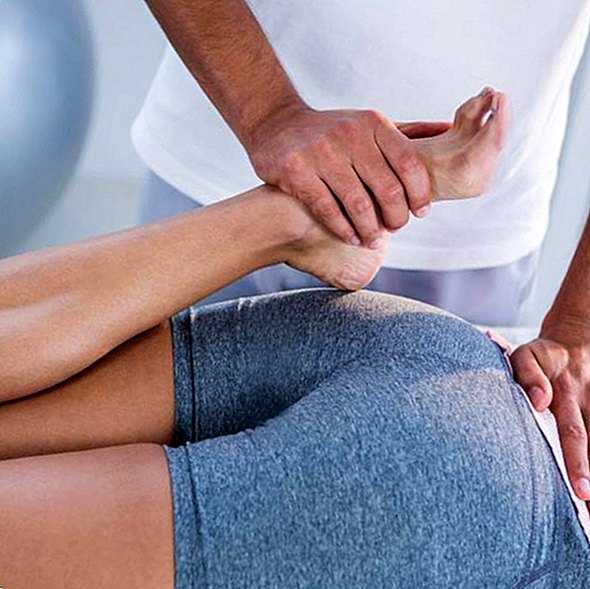Osteoporosis: When the bones crumble

Osteoporosis - what is it?
In osteoporosis, the bones become progressively more porous and brittle. The bones can break even on the slightest occasion, especially the vertebral body, femoral neck and wrists often hit.
Often sufferers also suffer from so-called silent fractures that they do not even notice, but cause pain. Especially the bone loss is triggered by hormone deficiency after menopause.
Who gets osteoporosis?
More than seven million Germans suffer from osteoporosis, including many women: Every fourth woman over 50 is affected. Women store less of the important bone building block calcium and therefore have a less stable skeleton than men. Although the female hormone estrogen strengthens the bones, during menopause its production declines sharply. That is why osteoporosis mainly affects older women.
Particularly at risk are also women who move little, whose ovaries were removed, who eat little milk or dairy products or have a strong underweight.
Osteoporosis can also be triggered by medications or other illnesses. For example, cortisone and blood thinners break the bones more easily, intestinal diseases such as Crohn's disease or hyperthyroidism cause the body to absorb calcium more poorly.
On the website of the board of trustees bone health you can do an osteoporosis risk test.
Which complaints should make me sit up?
Strong back pain is an alarm signal for osteoporosis, just as in recent years, someone has become smaller by several centimeters. In the worst case, the disease is not noticed until a bone breaks in an actually harmless situation - for example, when slipping off the curb.
How does the doctor determine if I am affected?
Bone atrophy can be determined by bone density measurementthat works with x-rays. However, the cost of the measurement will only be covered by the health insurance if there is a reasonable suspicion of osteoporosis.
How can you treat osteoporosis?
The patients receive the basic therapy calcium, usually 1000 milligrams a day, and Vitamin D. Painkiller and physical therapy help to get back on your feet when a vertebral body is already broken.
There are a number of effective and well-tolerated drugsthat are used against osteoporosis. Bisphosphonates inhibit bone resorption and strengthen the remaining bones, raloxifene strengthens the bones like estrogen, but does not increase the risk of breast cancer, but even lowers it. Strontium ranelate supports bone formation, as does teriparatide.
Since the body after menopause no longer produces natural bone protection hormones can Oestrogen tablets or patches help prevent bone loss. But they carry other serious health risks such as breast cancer or heart attack. All medications must be taken in long-term therapy over three to five years.
Are there any gentle healing methods?
At the pulsating magnetic therapy electromagnetic fields should promote bone formation. However, there is a lack of scientifically proven evidence that the process is actually effective.
The homeopathy recommends calcium salts such as calcium carbonicum and calcium fluoratum. mud relieve the pain, Feldenkrais or the Alexander Technique promote mobility.
Gentle, but most effective help against osteoporosis: In addition to the drug therapy, those affected should move a lot and to feed on calcium.
How can I protect myself?
Calcium full: Adults should take 1200 to 1500 milligrams of calcium per day. Especially milk, yoghurt and hard cheese, but also green vegetables such as broccoli or fennel are rich in the substance. When buying mineral water, pay attention to high calcium and sodium content.
Air and light: The body itself produces vitamin D, but requires UV radiation. In summer, half an hour a day is enough outdoors. In winter, additional vitamin D pills can make sense (doctor or doctor ask). Nicotine is a vitamin D predator and should therefore be avoided.
Move: The bone becomes firmer when loaded. Ideal are light strength training and specific gymnastics, so-called isometric exercises. Even if vertebral fractures have already occurred, it is important to rebuild muscles quickly with targeted training. Although strength training is optimal - but studies show that, for example, three times a week yoga significantly increases the bone density within two years.Doctors also recommend Qigong, the sliding movements of Chinese medicine, walking or swimming. The best 15 to 45 minutes a day and outdoors - in the light of the body's own vitamin D production is stimulated. It is important to move regularly: If you stop, you must expect that the bones will become more porous again soon.
Avoid falls: Especially if the bones have already become brittle, a fall can have fatal consequences. Therefore, you should avoid sleeping pills, tranquillizers and other medications that affect the circulation. Sport promotes coordination and helps to stay secure. And of course all pitfalls should be eliminated.
Where can I read on if I want more information?
The Federal Self-Help Association for Osteoporosis can order a brochure with addresses of ambulatory spa facilities, osteoporosis centers, doctors and self-help groups: Federal Self-Help Association for Osteoporosis e.V., Kirchfeldstraße 149, 40215 Düsseldorf, www.osteoporose-deutschland.de.
On the website of the board of trustees bone health, bone-friendly recipes are to be found in addition to many medical information.










